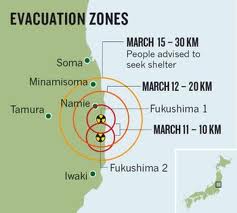My last post was about an old evacuation plan for the Seattle area in case of nuclear war. Although the danger of nuclear war is increasing, most of the current concern about evacuation relating to nuclear issues has to do with evacuation of populated areas in case of an accident at a nuclear power plant. Since the Fukushima disaster, there has been increased concern about evacuation. In the United States, the Nuclear Regulatory Commission has set evacuation standards for evacuation in case of accident.
The NRC requires populated areas near U.S. nuclear plants to have evacuation plans. Initially, the NRC calls for evacuation of a two mile radius around a nuclear power plant with an additional three miles downwind of the accident site. If the accident is very serious, there may be an evacuation of the area five miles from the plant with an additional five miles downwind. When the Fukushima disaster hit in Japan, the U.S. advised an evacuation of Americans within fifty miles of the power plant.
Japan shut down all of its nuclear power reactors after the Fukushima accident in March of 2011. The current Prime Minister of Japan is committed to restarting the reactors in spite of wide-spread public opposition. Part of the plan to restart the reactors concerns the drafting of evacuation plans in case of another severe accident like Fukushima. Creating and implementing realistic evacuation plans has proven to be more difficult than anticipated.
Minamata City is about twenty five miles from the Sendai nuclear power station. The evacuation plan calls for Sendai to create and maintain twenty eight facilities with hot water, supplies, staff and decontamination facilities to deal with evacuees coming from areas closer to the Sendai plant. Minamata City is not being offered any funds from the Japanese national government. It does not qualify for any regional or local subsidies. It is not close enough to the Sendai plant to be considers a "host" city and, therefore, cannot expect any financial assistance from the operators of the nuclear plant. Officials there say that they do not have the money that would be required for the twenty eight facilities.
Only thirteen percent of Japanese cities that are expected to be ready to receive evacuees from a nuclear accident currently have an evacuation plan. One hundred and seventy nine of the cities that are required to have an evacuation plan have reported that they do not have such a plan and are not working on drafting one. One city said that the national government expected their city to be ready to accept so many evacuees that they would be equal to about forty percent of the current population of the city.
Most of the cities near nuclear power plants that are slated for restart do have plans for evacuating their residents in case of nuclear accidents. However, when practice drills were held to test the evacuation plans, serious problems were found. In addition, as mentioned above, the cities that are supposed to accept those evacuees either cannot or simply will not make the preparations that would be necessary to house the refugees. Lack of funds is the most important reason given.
The inadequacy of evacuation planning and funding is one of the main reasons that a majority of the Japanese public is so against restarting the Japanese nuclear power reactors.
